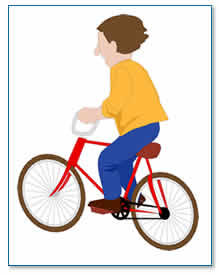schools,
rivers and waste
 |
School children
using paper |
Schools are places where lots
of people come together from the local community to spend quite
a lot of their time. Have a go at working out how much time you
spend in school a week, and then think about a whole year! With
so many people and so much time spent there, schools are places
that can have quite an impact on the environment, sometimes in a
bad way, but also in a positive way with a little thought.
Farming (W06)
and other industries (W03),
have been seen to have direct impacts upon waste being released
into rivers and therefore the water cycle (B02).
For example, mining and quarrying or livestock farming and pesticide
use can lead to soil, minerals and chemicals entering the watercourse.
In the page ‘Homes, rivers
and waste’ (W05)
the results of waste released into the water cycle and pollution
were less obvious because the water which contained the waste was
taken away in the sewage system. When the results of an action are
not seen straight away or not found at the same place as the cause
of the pollution, it is harder for people to see that there is a
connection and that they can take steps to help.
We have already acknowledged
that schools have a lot of people in them for most days of the week
and most weeks of the year. All these people are using materials
like paper, plastic and electricity, eating food, using the sinks
and toilets and travelling to and from school each day.
 |
Lunch time |
So even though a school may not be producing paper, like a paper
mill or growing crops for food, like a farm, a school is still using
these things, or products each day and has to buy them. In this
way the school has ‘Purchasing Power’, this means it
can chose from where it buys food (for school meals), paper, equipment
and cleaning products. Every individual and organisation or industry
has this purchasing power.
 |
Packaged food |
Schools can choose to buy products from companies who try and reduce
their impact on the environment. For example, buying recycled paper,
which is non-bleached, means that less energy and water has gone
into making the paper. It also means that pesticides and other chemicals
are not needed to keep on growing new trees to replace those cut
down for new paper. If the paper is non-bleached, it is better for
the environment because bleach is a powerful chemical that kills
plants and animals. This is especially the case in the watery environment
where it ends up, affecting the balance of nature.
 |
Walking to school |
This is just one example of purchasing
power, another is buying organic locally grown foods, and reducing
the amount of processed and highly packaged food bought. Visit the
Soil Association website for more information. As well as having
direct positive effects for the environment (by reducing chemicals
used to grow the crops and transport and package them) and therefore
the health of all the creatures and plants that share the planet,
it could also have direct health benefits for the pupils and teachers
eating this kind of food. For more information visit the WHO website.
 |
Cycling to school |
Another example which will help to reduce the amounts of waste entering
the environment and the water cycle in particular, is to reduce
the need to use motorised transport. If you live only a short distance
from your school, walk instead of getting a lift. The school gates
would be a much safer place if there weren’t so many cars
about. Your parents and teachers might be worried about the busy
roads on the journey but there are safe and fun ways to travel to
school on foot, have you heard of the walking bus? Visit council
website page, Sustainable Transport for more information.
There are things that you will
notice on your journey to school in the morning that you would never
see, hear, smell or feel if you were in a car. If the distance is
a bit too far to walk, what about cycling? You could even be involved
in creating a cycle route! (visit Groundwork or Council websites).
|

